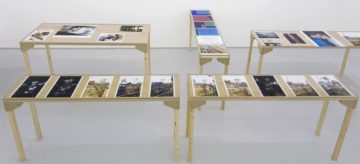Claire Bishop at Artforum:
 EACH PHASE of research-based art presents a different understanding of what constitutes knowledge and a different approach to spectatorial labor. In the first phase, the artist invites the viewer to piece together parts from the materials provided to form their own historical narrative and to experience in their bodies and minds the complexity of a given (usually counterhegemonic) topic. Knowledge aspires to be new knowledge. In the second phase, the viewer listens to or reads a narrative crafted by the artist. Facts may be partly fictionalized, but there remains a sense of correcting or enhancing history, often through a counter- or micronarrative. The third phase returns the viewer to sifting through information, albeit now in a formal, less interactive mode. Knowledge is the aggregation of preexisting data, and the work accordingly invites meta-reflection on the production of knowledge as truth. In each case, though, despite creating the look or atmosphere of research, artists are reluctant to draw conclusions. Many of these pieces convey a sense of being immersed—even lost—in data.
EACH PHASE of research-based art presents a different understanding of what constitutes knowledge and a different approach to spectatorial labor. In the first phase, the artist invites the viewer to piece together parts from the materials provided to form their own historical narrative and to experience in their bodies and minds the complexity of a given (usually counterhegemonic) topic. Knowledge aspires to be new knowledge. In the second phase, the viewer listens to or reads a narrative crafted by the artist. Facts may be partly fictionalized, but there remains a sense of correcting or enhancing history, often through a counter- or micronarrative. The third phase returns the viewer to sifting through information, albeit now in a formal, less interactive mode. Knowledge is the aggregation of preexisting data, and the work accordingly invites meta-reflection on the production of knowledge as truth. In each case, though, despite creating the look or atmosphere of research, artists are reluctant to draw conclusions. Many of these pieces convey a sense of being immersed—even lost—in data.
more here.
